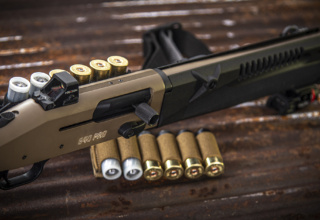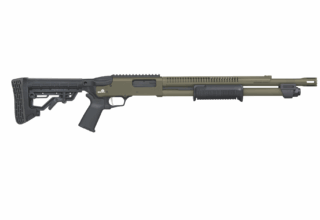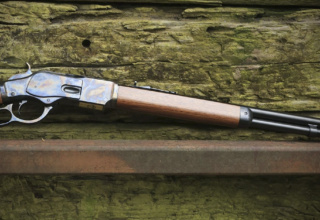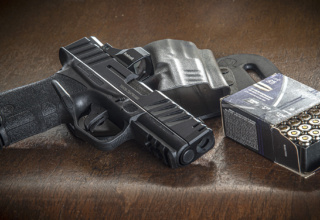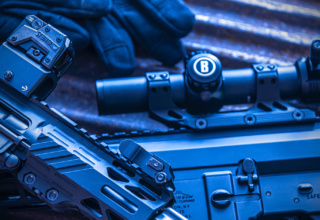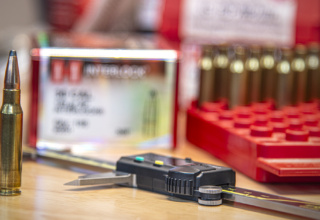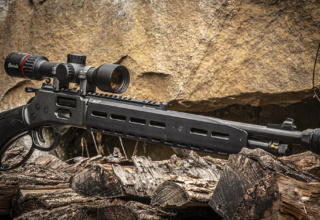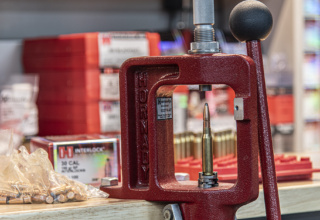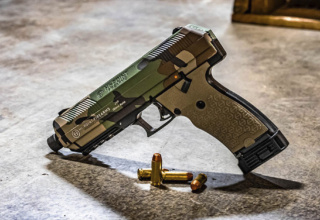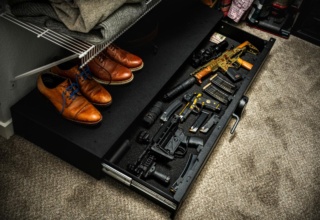There are many reasons why we enjoy hunting and shooting. Being outdoors in the pursuit of game or the perfect shot group rank at the top, but in all this, there is the element of the challenge.
One challenge that delivers big dividends is building your own rifle—specifically, a muzzleloader.
A couple years ago, we decided to build our first blackpowder rifle using the Traditions Performance Firearms percussion Kentucky Rifle kit. It was a big learning experience and one of the most satisfying projects we’d ever tackled. The build itself was a blast, but the real fun came after we hit the range and spent time developing the ideal load, adjusting the sights, and making tight holes with 19th century firearm technology. Then, of course, came the hours spent in the field, pursuing whitetail deer with a rifle we had put together and finished with a parts kit.
Having been truly bitten by the muzzleloader bug, we decided to take our blackpowder endeavors one step farther by building a flintlock-style rifle.
Like all their muzzleloader kit rifles, Traditions Performance Firearms’ Mountain Rifle Flintlock Kit comes with all wood and metal components in-the-raw. Although assembling a kit takes time and patience, it is easily accomplished with a few basic hand tools.

After perusing the numerous rifle kits offered by Traditions Performance Firearms, we settled on the .50-caliber Mountain Rifle Flintlock Kit (PN KR59208). Based on the ubiquitous Hawken design, the Traditions do-it-yourself Mountain Rifle Kit includes all the components to assemble a working flintlock. The 32-inch octagonal barrel and all metal components are unfinished (except for the lock assembly, which comes case-hardened), requiring final polish and finish (bluing or browning). The hardwood stock is shaped and inletted at the factory, but that, too, requires plenty of work on the builder’s part in the form of parts fitment, finish-sanding, staining, and final finish.
One of the many appealing aspects of building your own muzzleloader is the opportunity to customize. For example, the barrel and raw metal components can be either blued (black oxide) for a more conventional finish or browned for that old-school look. Variations are also possible with your choice of stain color, protective wood coating (gloss, matte, or throwback rubbed oil), as well as the addition of custom brass work, carving, inlays…the choices are endless.
The best part of a Traditions muzzleloader kit is that you don’t have to be an experienced gunsmith, machinist, or wood craftsman to build a rifle you’d be proud to hang above the fireplace or to take to the range. The mechanics of a muzzleloader sidelock and trigger assembly are straightforward and easy to understand, and the minor woodworking and metal finishing involved is on the level of the beginner. If you are comfortable using sandpaper, wood and metal files, wood chisel, screwdrivers, and maybe a Dremel, you’ve got this.
Have doubts? Read on… All Traditions Performance Firearms muzzleloader kits include detailed assembly instructions that even the first-timer can follow to successful completion. The assembly process starts by fitting all components together. The heart of the assembly is the sidelock mechanism, which must fit flush in the stock inlet. The factory inletting is usually a bit tight, requiring small amounts of wood removal for the sidelock to fit flush and snug. A combination of wood chisel, wood scraper (utility knife blade), or a Dremel fitted with a grinding stone will allow you to size the inletting just right. The key is to take your time, take a little off, and test-fit.
All Traditions Performance Firearms muzzleloader kits include detailed assembly instructions that even the first-timer can follow to successful completion. The assembly process starts by fitting all components together. The heart of the assembly is the sidelock mechanism, which must fit flush in the stock inlet. The factory inletting is usually a bit tight, requiring small amounts of wood removal for the sidelock to fit flush and snug. A combination of wood chisel, wood scraper (utility knife blade), or a Dremel fitted with a grinding stone will allow you to size the inletting just right. The key is to take your time, take a little off, and test-fit. Once the sidelock is set, fitment of the trigger assembly, barrel tang, and barrel can begin. This can be the most challenging part of a muzzleloader assembly because these various parts must go together and work as one unit. Getting one part to seat in its inlet doesn’t mean that screw holes or mechanical alignment will be correct in relation to another component that is also seated in its inlet. Fit-test-fit-test is the rule here. Again, go slowly and in small increments.
Once the sidelock is set, fitment of the trigger assembly, barrel tang, and barrel can begin. This can be the most challenging part of a muzzleloader assembly because these various parts must go together and work as one unit. Getting one part to seat in its inlet doesn’t mean that screw holes or mechanical alignment will be correct in relation to another component that is also seated in its inlet. Fit-test-fit-test is the rule here. Again, go slowly and in small increments. All barrel components of the muzzleloader are secured via dovetails. The barrel tenons, which secure the barrel to the forestock via two barrel wedge pins, are first to go on. These slide in from the right side of the barrel, and often require minor filing before they can be snugly seated into the barrel dovetail slot. Filing them in a figure-eight pattern across a flat file or aluminum oxide cloth will reduce the bases enough for proper fitment. Just don’t take too much off, as these need to have a fairly tight interference fit when installed. Always use a brass punch or drift to install the tenons to avoid damaging the steel components. The same procedures are used to fit the front and rear sights onto the barrel.
All barrel components of the muzzleloader are secured via dovetails. The barrel tenons, which secure the barrel to the forestock via two barrel wedge pins, are first to go on. These slide in from the right side of the barrel, and often require minor filing before they can be snugly seated into the barrel dovetail slot. Filing them in a figure-eight pattern across a flat file or aluminum oxide cloth will reduce the bases enough for proper fitment. Just don’t take too much off, as these need to have a fairly tight interference fit when installed. Always use a brass punch or drift to install the tenons to avoid damaging the steel components. The same procedures are used to fit the front and rear sights onto the barrel. Once all the brass work and rifle components have been installed and the sidelock/trigger assembly functions correctly, disassemble the rifle but leave the brass installed on the stock. This is necessary to achieve a smooth transition between the wood and the brass nose cap, butt plate assembly, and stock plates.
Once all the brass work and rifle components have been installed and the sidelock/trigger assembly functions correctly, disassemble the rifle but leave the brass installed on the stock. This is necessary to achieve a smooth transition between the wood and the brass nose cap, butt plate assembly, and stock plates. The stock should be sanded using increasingly finer sanding medium, up to 600-grit paper for optimal results. Begin by reducing the high areas around the butt plate and nose cap with coarse paper (here’s where the elbow grease comes in). Do not worry about sanding over and scuffing the brass furniture. These will be polished back down once the wood is reduced to a seamless transition. After the wood has been sanded to the 400- or 600-grit level, the finish work can begin. You can piece together your own stain and topcoat combination or purchase the Traditions Complete Gun Stock Finishing Kit. We opted for a little of both because of our desire for a bit of customizing.
The stock should be sanded using increasingly finer sanding medium, up to 600-grit paper for optimal results. Begin by reducing the high areas around the butt plate and nose cap with coarse paper (here’s where the elbow grease comes in). Do not worry about sanding over and scuffing the brass furniture. These will be polished back down once the wood is reduced to a seamless transition. After the wood has been sanded to the 400- or 600-grit level, the finish work can begin. You can piece together your own stain and topcoat combination or purchase the Traditions Complete Gun Stock Finishing Kit. We opted for a little of both because of our desire for a bit of customizing. To give our wood stock some added character and more of an old-school feel, we first applied a dark walnut stain to the stock. While the stock was drying, we turned our attention to the barrel, first by removing the tenons and sight components.
To give our wood stock some added character and more of an old-school feel, we first applied a dark walnut stain to the stock. While the stock was drying, we turned our attention to the barrel, first by removing the tenons and sight components. The “in-white” barrel comes with factory machining scores along the flats. These must be polished out to achieve a smooth finish. Reload on the elbow grease and, using increasingly finer grit aluminum oxide paper, work the flats down to a mirror-like surface. We started with an aggressive medium-grit Emory cloth and finished with 600 grit aluminum oxide, followed by super-fine steel wool.
The “in-white” barrel comes with factory machining scores along the flats. These must be polished out to achieve a smooth finish. Reload on the elbow grease and, using increasingly finer grit aluminum oxide paper, work the flats down to a mirror-like surface. We started with an aggressive medium-grit Emory cloth and finished with 600 grit aluminum oxide, followed by super-fine steel wool.
Here is where the builder has a choice between bluing or browning. We chose browning for its period-correct look and we wanted to give the barrel a slight “worn-and-aged” patina in the process. More on that in a moment. For those who favor conventional blued gunmetal, Traditions also offers a single-solution cold blue formula that is so simple to use it’s almost scary. Simply clean the raw and polished barrel with denatured alcohol, apply the Traditions Liquid Blue, rinse with cold water, dry, and repeat until you achieve the desired finish. It is definitely easier than browning with Birchwood Casey’s Plum Brown… There are several methods and formulas to use when browning a muzzleloader barrel, but Plum Brown does a good job of it, and by varying the heat and pre-rinse set time, we were able to give our barrel a subtle patina to compliment what we planned for the stock. This process requires heating the metal (we used a propane torch) to around 275º F and swabbing on the solution. Once the metal is cool enough to handle, rinse thoroughly with cold water and apply a lubricant to allow the finish to cure. We’ve found no better post-finish cure than Rig Universal Gun Grease. Thoroughly coat the metal with Rig and leave for at least 24 hours to complete the finish process.
There are several methods and formulas to use when browning a muzzleloader barrel, but Plum Brown does a good job of it, and by varying the heat and pre-rinse set time, we were able to give our barrel a subtle patina to compliment what we planned for the stock. This process requires heating the metal (we used a propane torch) to around 275º F and swabbing on the solution. Once the metal is cool enough to handle, rinse thoroughly with cold water and apply a lubricant to allow the finish to cure. We’ve found no better post-finish cure than Rig Universal Gun Grease. Thoroughly coat the metal with Rig and leave for at least 24 hours to complete the finish process.
Regarding our “custom patina” look, we ran our temperatures a bit on the high side and gave the barrel several swabs of solution as it cooled, creating somewhat uneven browning results. This was followed by rinsing, drying, and vigorously rubbing the metal with 000 steel wool before repeating the process two more times. The result was the pleasing, old-barrel look we were shooting for. With all the metal components browned (barrel, tang, trigger guard, thimbles, and thimble rib) and curing under Rig grease, our attention turned back to the stock. We had applied a dark walnut stain to the light hardwood, knowing that, once re-sanded, the areas with open wood pores would hold some of the stain while the closed-pore areas would lighten up. The result is added character in an otherwise monotone wood. It did take a lot more sanding than we anticipated to bring out the mottled look we were after because the stain particulates quickly loaded up the fine-grit sandpaper. After the final 600-grit sanding, we turned to our bottle of Traditions walnut stain, diluting it with a small amount of mineral spirits, and applied. This gave us the warm hue we wanted in the wood highlights without making the overall stock appear too dark. Once the second coat of stain dried, we lightly rubbed the stock with 600-grit paper to knock down any raised fibers and then applied our first coat of Traditions Stock Finish and let dry for 24 hours.
With all the metal components browned (barrel, tang, trigger guard, thimbles, and thimble rib) and curing under Rig grease, our attention turned back to the stock. We had applied a dark walnut stain to the light hardwood, knowing that, once re-sanded, the areas with open wood pores would hold some of the stain while the closed-pore areas would lighten up. The result is added character in an otherwise monotone wood. It did take a lot more sanding than we anticipated to bring out the mottled look we were after because the stain particulates quickly loaded up the fine-grit sandpaper. After the final 600-grit sanding, we turned to our bottle of Traditions walnut stain, diluting it with a small amount of mineral spirits, and applied. This gave us the warm hue we wanted in the wood highlights without making the overall stock appear too dark. Once the second coat of stain dried, we lightly rubbed the stock with 600-grit paper to knock down any raised fibers and then applied our first coat of Traditions Stock Finish and let dry for 24 hours. With the stock drying, attention turns to polishing the sanding scratches out of the brass. As with any sanding operation, begin with only the most aggressive grit needed to remove the deepest scratches, them progressively shift to finer grit paper and finally to steel wool. We screwed the brass stock plates to a board to make polishing these small parts a bit easier.
With the stock drying, attention turns to polishing the sanding scratches out of the brass. As with any sanding operation, begin with only the most aggressive grit needed to remove the deepest scratches, them progressively shift to finer grit paper and finally to steel wool. We screwed the brass stock plates to a board to make polishing these small parts a bit easier.
The barrel can now be cleaned of grease and populated with the tenons and sight fixtures. Remember…install from right to left. For a truly top-notch stock finish, wet-sanding is a must. After the first thin coat of finish has been applied, pour a small amount of finish in a separate bottle and lightly dilute it with mineral spirits. Apply to small sections of wood and, using 600-grit paper, begin sanding to create a light slurry of finish and wood dust. Wipe off with a clean, lint-free cloth against the grain so the slurry fills in low spots between the wood fibers. Allow to dry before adding the next coat.
For a truly top-notch stock finish, wet-sanding is a must. After the first thin coat of finish has been applied, pour a small amount of finish in a separate bottle and lightly dilute it with mineral spirits. Apply to small sections of wood and, using 600-grit paper, begin sanding to create a light slurry of finish and wood dust. Wipe off with a clean, lint-free cloth against the grain so the slurry fills in low spots between the wood fibers. Allow to dry before adding the next coat.
Once the final finish coat is applied, you may wish to dull down the high gloss shine. This can be done by LIGHTLY running over the cured finish with super-fine steel wool. You only want to rub enough to bring down the gloss to a fine luster. For a more satin or matte finish, apply one to three coats of Birchwood Casey Stock Sheen & Conditioner. This will further dull a high-gloss shine and help fill in any remaining surface imperfections. When finished, a light coat of furniture wax will help protect your stock from the elements.
For a more satin or matte finish, apply one to three coats of Birchwood Casey Stock Sheen & Conditioner. This will further dull a high-gloss shine and help fill in any remaining surface imperfections. When finished, a light coat of furniture wax will help protect your stock from the elements.
At this point, the rifle is ready for final assembly. Note that some finish may have seeped into the inletting, preventing the components from seating correctly. A utility knife razor blade works well for scraping out finish overrun. The completed rifle may look like a mantle piece, but you’ve built more than a wall-hanger. Take it to the range, zero the sights, and go hunting. This is what the fun of building your own muzzleloader is all about!
The completed rifle may look like a mantle piece, but you’ve built more than a wall-hanger. Take it to the range, zero the sights, and go hunting. This is what the fun of building your own muzzleloader is all about!


